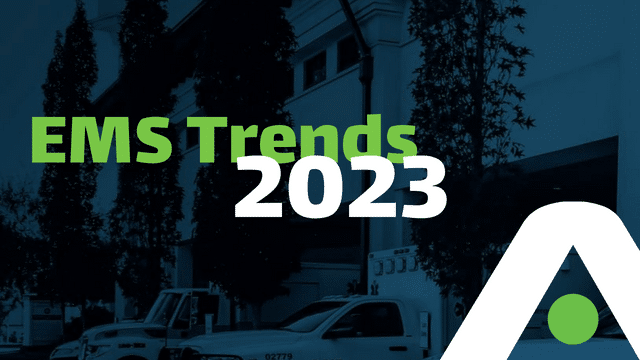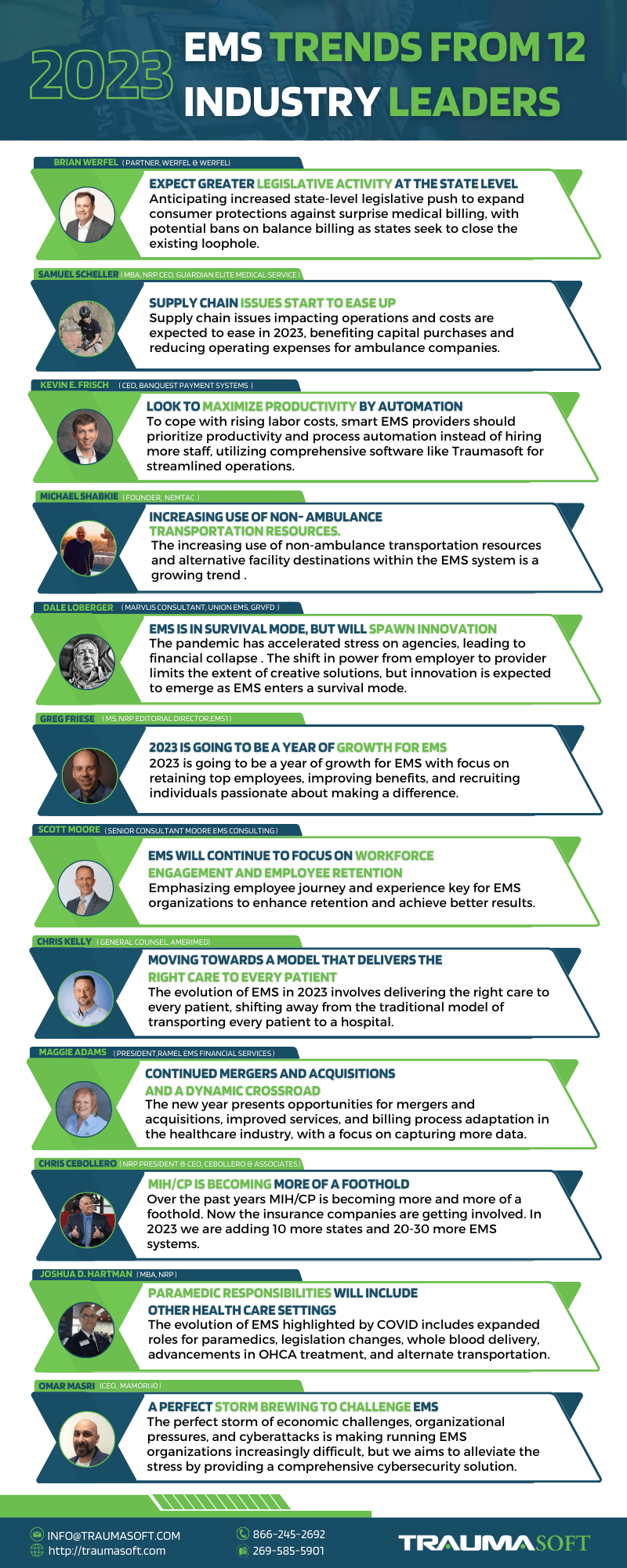
The Emergency Medical Services (EMS) industry has evolved significantly since 2020. From how EMS operates to the regulatory landscape, change seems to be happening in every corner. Preparing for what’s coming seems to be ever-more challenging. Thankfully, 12 industry leaders shared their insights on EMS hot topics and trends to help us navigate through times of uncertainty.
Below are their responses in both infographic and text. The infographic summarizes their responses, and the article provides their full comment. If you’re short on time, just read the text in bold to get the main points.

1. Expect Greater Legislative Activity at the State Level

Brian Werfel
Partner, Werfel & Werfel
The one trend that immediately comes to mind is greater legislative activity at the state level. I think we are going to see a greater push at the state level to expand the consumer protections against surprise medical billing. As you probably know, the federal No Surprises Act exempted ground ambulance services from these restrictions. As a result, we are currently the only health care industry that is still balance billing patients. One of the predictable consequences of that exclusion is a significant uptick in complaints being filed with state agencies. In many cases, this has led to unfavorable media coverage, which frequently characterizes our exclusion as a “loophole.” There are several bills in state legislatures that would ban balance billing outright. I think some of these are likely to pass in 2023, as states look to close that loophole.
2. Supply Chain Issues Start to Ease Up

Samuel Scheller, MBA, NRP
I am hopeful that in 2023 we see the supply chain issues start to ease up. Over the last couple of years, the supply chain issues have impacted our ability to make capital purchases, thus impacting other areas of our operations. As these supply chain issues begin to subside, we should also be seeing a decrease in the cost to operate as supply chain issues has been directly attributed to the rising costs ambulance companies are facing.
3. Look to Maximize Productivity by Automation

Kevin E. Frisch
CEO, Banquest Payment Systems
With labor costs surging on a year-on-year basis, smart EMS providers should be looking to maximize productivity of existing teams by implementing greater efficiencies and automating processes rather than increasing headcount.
Utilizing a software like Traumasoft for only one part of your process but utilizing other systems to handle the other processes slows down operations and increases room for error. For the greatest workforce optimization, operators should invest the time to learn all the capabilities, functions and integrations that technologies like Traumasoft offer and put them into operation. It may be a learning curve at first but the ROI will be significant and long term.
4. Increasing Use of Non-Ambulance Transportation Resources

Founder, Non Emergency Medical Transportation Accreditation Commission (NEMTAC)
The first topic that popped into my head is the increasing use of non-ambulance transportation resources within the EMS system along with alternative facility destinations other than the ED. There has been a monumental shift in practices among some EMS systems that are struggling with recruitment and retention of EMS personnel. Earlier this year, I was able to take a deep dive and write an article, Can NEMT Companies Save the EMS System?
The trend of right sizing the EMS system has accelerated post-covid and will be something to watch in 2023.
5. EMS is in Survival Mode, but will Spawn Innovation

MARVLIS Consultant, BCS; FTO, Union EMS; Captain, GRVFD
The best description I’ve heard for the current situation in EMS is “labor pains.” These words have a double-meaning as we obviously have a severe staffing issue, but it is that created-shortage of labor that is also likely to give birth to new structures in prehospital care out of fiscal necessity. The pandemic has accelerated trends that continue to stress many agencies, both rural and urban, occasionally to the very brink of financial collapse. Those who can, have been forced to seek additional operating funds from the local governments they serve. That abrupt change in the bottom-line with dramatically increased expenses is also opening opportunities for fire departments not currently providing transport to compete for those same limited tax dollars by offering to collapse EMS into fire services.
A shortage of paramedics is also forcing services to reconfigure their basic structure. Once proudly “all-ALS” agencies must now consider tiered responses allowing them to convert a portion of their fleet to BLS-level skills. Teleconferencing and nurse triage lines are also being used in some areas to sort or eliminate transports. Aside from slowing the escalation of operating costs, these structural changes should also allow more entry-level medical providers to work at the top of their scope of practice and possibly encourage advancement (if not abandonment) of their careers in EMS.
The pendulum of power has definitely swung from the employer toward the provider. This means that broader operational initiatives that once sought to improve safety by reducing hours of work or miles of responses are now less affordable priorities as funds shift toward wages to simply keep shrinking fleets available. While innovative solutions are being sought, the competing interests of reality limit the extent of creativity in those new ideas. For the next several years, I suspect EMS to be in survival mode, but that doesn’t necessarily mean administrative retreat as the fight for life spawns innovation. Additionally, potential legal changes, such as meaningful “essential service” status, could further alter the current environment. At the very least, watch for more consolidation announcements.
6. 2023 is Going to be a Year of Growth for EMS

Greg Friese, MS, NRP
Editorial Director, EMS1
2023 is going to be a year of growth for EMS. The profession will build off the encouraging successes in 2022 to invest in retaining their top employees by paying a thriving wage, improving benefits and reducing hospital drop-off times. I also think EMS employers are going to continue their successes in recruiting new personnel through earn-while-you-learn programs and seeking out people who want to make a difference in the lives of others. For people who want to serve their community, this is a great time to join and be a part of EMS.
7. EMS will Continue to Focus on Workforce Engagement and Employee Retention

Senior Consultant & Show Host, Moore EMS Consulting
I believe that EMS organizations and the leadership teams that guide them will continue to dig into the foundational elements of what drives workforce engagement and overall employee retention. For EMS employers to be successful, they will need to focus on the employee journey. This will include what an employee experiences from when they consider pursuing an EMS certification to when they apply for, and accept, a job in EMS. Additionally, it will be critical for EMS leaders to consider what the EMS employee is seeking during their time in EMS, whether it is for a life-long EMS journey, or a career in another field. The focus will need to shift to the whole employee rather than just the work they perform for the EMS agency. Employers who can shift their mindset to the employee experience and role that employees want work to play in their lives, will enjoy higher retention rates and better organizational results.
8. Moving Towards a Model that Delivers the Right Care to Every Patient

Chris Kelly
Attorney, Page, Wolfberg & Wirth
I think the way we provide EMS will continue to evolve in 2023, moving away from the model that delivers every patient to a hospital, toward a model that delivers the right care to every patient. Whether it’s a protocol or process that allows dispatch to send a service other than an ambulance to a patient, or if it’s driven by EMS crew determinations in the field that patients can be treated-in-place, offered telehealth services, or taken to destinations other than a hospital, or if it’s accomplished by proactive measures that focus on meeting the needs of a person so that they do not make that 9-1-1 call to begin with- the way we provide care is changing. And it must. Patient needs, community expectations, staffing shortages, hospital delays, and payer policies are just some of the factors that are driving this change. Any of these individually could nudge us toward an evolution of EMS, but taken together they demand it. The good news is we are making the necessary adjustments already, and we see the path forward. This path will continue to open up and become even more clear in 2023.
9. Continued Mergers and Acquisitions and a Dynamic Crossroad

President, EMS Financial Services
The new year will see the continuation of mergers and acquisitions among both providers and billing companies. For some ambulance services, joining forces makes good sense as they can better leverage resources and ensure service continues – particularly in under-served and rural areas.
Billing company mergers mean that providers who outsource their billing may need to get used to new processes. However, a new billing company can be an opportunity for both the provider and the vendor – relationships can be revisited and enhanced, better reporting may become available, and provider education can grow. For providers who land with a new billing company, it’s a good idea to check their billing performance and compliance by having an audit done in six months to a year.
For emergency services, 2023 will be a good time to take a look at their emergency dispatch protocols. Work with your Medical Director, operations management and your call-center to ensure that your protocols reflect the true BLS and ALS issues that occur in your community. Further, make sure your emergency dispatch protocols are in compliance with Medicare’s guidance. Consideration of emergency dispatch is critical when billing for ALS services. Government audits continue for emergency providers. For non-emergency providers who receive emergency calls directly from local facilities, it is critical that your internal dispatch protocols are strong and in compliance. Emergency services continue to be as sensitive to compliance & audit concerns as non-emergency services.
A dynamic crossroad has emerged and with it an opportunity for EMS software companies and providers alike. Community paramedicine/mobile integrated healthcare is growing nationwide. At the same time, commercial payers have become more tuned to the social determinants of health (SDOH). Therein lies the crossroad – MIH is growing, and commercial payers are very interested in SDOH. Payers like Aetna-CVS, United Healthcare, UPMC Health Plan, and Kaiser Permanente have committed massive resources to respond to SDOH topics like homelessness, food inequities, access to transportation, etc. Concurrent to these developments, the American Medical Association joined forces with payers to expand the list of available SDOH codes so that data on SDOH can be better captured. SDOH problems like homelessness, social exclusion, alcohol and drug use, problems related to living alone are the types of issues EMS sees every day. With payer focus on SDOH and our industry’s movement to more mobile integrated healthcare, we have a huge opportunity to capture more data on these topics and ultimately receive reimbursement for MIH responses. There is a billing code (A0998) for treatment without transport. More commercial payers recognize this code. If EMS employs this code on billing and adds an SDOH code to their claims to describe the patient condition, we will be providing more data to payers that supports our efforts to expand MIH. Our trips reports are rich with information on the problems EMS sees in the field. Capturing more information from our reporting will also point to MIH opportunities and alliances that can be had with other healthcare providers (home health, hospice, chronic disease management, drug and alcohol treatments). My hope is that software vendors and providers will work together to better capture that data so that the people with the pocketbooks learn more about our participation and support for these challenging problems.
10. MIH/CP is Becoming More of a Foothold

Chris Cebollero, NRP
President & CEO, Cebollero & Associates
Over the past years MIH/CP is becoming more and more of a foothold. Now the insurance companies are getting involved. I’m part of the largest pilot with a large payer that includes 8 states, and 20 EMS systems. In 2023 we are adding 10 more states and 20-30 more EMS systems. Universal reimbursement for community paramedic home visits are just around the corner.
11. Paramedic Responsibilities will Include Other Health Care Settings

Joshua D. Hartman, MBA, NRP
Senior Vice President, Cardiovascular & Public Safety Divisions, HMP
EMS continues to be in an evolutionary pathway. COVID exposed several positive factors related to EMS professionals. In addition to showing how EMS professionals could diagnose and treat COVID patients in several different settings, COVID also demonstrated versatility of our capabilities. For example, of all the professionals staffing a vaccination center, often it was the paramedic who was able to perform at every role such as intake/assessment, drawing up the vaccination, administering the vaccination, monitoring for post vaccination side effects, and treating the rare, but significant complication. In the not distant future, this will make its way into legislation in areas where paramedics are currently restricted to the traditional EMS environs to now include responsibilities in other health care settings. Other trends and advances as part of this evolution is delivery of whole blood into the field, advances in the treatment of OHCA, and alternate transportation pathways for patients who may be best treated in a setting other than the traditional emergency department.
12. A Perfect Storm Brewing to Challenge EMS

Omar Masri
CEO, Mamori.io
A major trend I see is that there is a perfect storm brewing to challenge EMS organizations both economically and organizationally. First, you have Health insurance providers and government regulations squeezing transport provider revenue. Second, you have rising inflation increasing operational cost and staff stress levels, and finally you have the unrelenting growth of cyberattacks aimed at extorting money from EMS organizations and disrupting business continuity.
At Mamori.io we recognize that running an EMS organization is becoming increasingly challenging and stressful, and that is why we are focused on helping EMS organizations protect themselves from modern cyberattacks with a comprehensive, easy to deploy, and cost-effective cybersecurity solution. Our mission is to remove the stress of cybersecurity from EMS business owners. Traumasoft is using Mamori.io to secure its valuable data, and we are happy to help all their partners and customers do the same.
About Traumasoft
Traumasoft is one truly integrated product for Emergency Medical Services (EMS) that drives timely efficiencies. We are an all-in-one system capable of managing every aspect of your EMS operations. One system comprised of interconnected solutions handles staff, integrates processes, manages assets, and grows revenue. Schedule a demo today to see how we can help you increase operation efficiency and profitability.